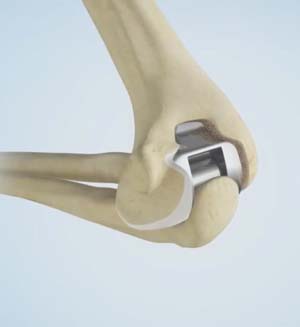
Elbow Anatomy
The arm in the human body is made up of three bones that join to form a hinge joint called the elbow. The upper arm bone or humerus connects from the shoulder to the elbow to form the top of the hinge joint. The lower arm or forearm consists of two bones, the radius, and the ulna. These bones connect the wrist to the elbow forming the bottom portion of the hinge joint.
What is Arthritis?
Arthritis is a general term that covers numerous conditions in which the joint surfaces wear out. The joint surface is covered by a smooth articular surface made of cartilage that allows pain-free movement in the joint. This surface can wear out for several reasons. Often the definite cause is unknown.
When the articular cartilage wears out, the bone ends rub on one another, causing pain, swelling, stiffness, and interference with the use of the arm. In general, arthritis affects people as they get older.
Treatment Options for Elbow Arthritis
Treatment can include conservative options such as medications and steroid injections to relieve pain, activity modification and use of splints, or surgery.
What is Total Elbow Replacement?
Elbow joint replacement, also referred to as total elbow arthroplasty, is an operative procedure to treat the symptoms of arthritis that have not responded to non-surgical treatments. The goal of elbow joint replacement surgery is to eliminate pain and increase the mobility of your elbow joint.
Indications for Total Elbow Replacement
Elbow joint replacement surgery may be recommended by your surgeon for the treatment of severe arthritis that has not responded to conservative treatment options.
Other indications for elbow joint replacement surgery may include:
- Severe elbow fracture in older patients with osteoporosis
- Tumor or growth in the elbow joint
- History of previous elbow surgery
Total Elbow Replacement Procedure
The surgery is performed under sterile conditions in an operating room under general or regional anesthesia and involves the following steps:
- An incision is made over the back of the elbow.
- The muscles are retracted, and the elbow joint is exposed. Care is taken to protect the ulnar nerve to prevent nerve damage.
- The damaged joint surfaces of the humerus, radius, and ulna are trimmed with a surgical saw to create a smooth surface for the attachment of the implants.
- A special instrument is used to hollow out the inside of the humerus bone to insert the humeral component of the prosthesis.
- Once a proper fit is established, your surgeon repeats this procedure on the ulna bone to prepare it for the ulnar component of the prosthesis.
- The humerus and ulna bones are then prepared with or without cement, depending on your surgeons preference.
- The components are then inserted and put together, ensuring proper movement of the hinge portion of the prosthesis.
- With all the new components in place, the joint is tested through its range of motion.
- Your surgeon then irrigates the new joint with sterile saline.
- The joint capsule is sutured back together, the muscles and tendons are repaired and the skin is closed. The surgeon may leave drain in place to help any blood drain from the area.
- The elbow is then dressed and bandaged.
Postoperative Care for Total Elbow Replacement
After surgery, your surgeon will give you guidelines to follow depending on the type of repair performed. The common postoperative guidelines include the following:
- Your arm will be in a sling or splint with a bulky dressing.
- You may have a drain tube present to allow blood to drain from the incision. This will usually be removed the day after surgery.
- Elevating the elbow on a pillow above heart level and applying ice packs over the dressing will help reduce swelling and discomfort.
- Occupational therapy (OT) will begin soon after surgery and continue for about 3 months to regain range of motion of the elbow joint.
- Sutures will usually be removed after 10-14 days.
- Keep the incision clean and dry. You may shower once the dressings are removed unless otherwise directed by your surgeon.
- You will be given specific instructions regarding activity and rehabilitation. You will have a lifetime lifting restriction of no more than 5 pounds with the affected arm.
- Eating a healthy diet and not smoking will promote healing.
Risks and Complications of Total Elbow Replacement
Complications can occur following elbow replacement surgery and may include:
- Infection
- Fractures of the humerus or ulna bone
- Dislocation of the elbow
- Loosening of the prosthesis
- Damage to the nerves or blood vessels
- Blood clots (deep venous thrombosis)
- Wound irritation
- Failure to relieve pain
Related Topics
- Open Elbow Surgery
- Distal Biceps Repair
- ORIF of the Humerus Fractures
- Radial Head ORIF and Replacement
- Common Extensor Tendon Origin Repair
- Total Elbow Replacement
- Elbow Arthroscopy
- ORIF of the Coronoid Fractures
- Elbow Ligament Reconstruction
- Elbow Tendon and Ligament Repair
- UCL Reconstruction (Tommy John Surgery)
- Tennis Elbow Surgery
- Ulnar Nerve Release
- Ulnar Nerve Transposition
- ORIF of the Distal Humerus Fractures
- ORIF of the Olecranon Fractures
- Ulnar Collateral Ligament (UCL) Repair with Internal Brace





